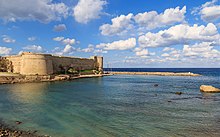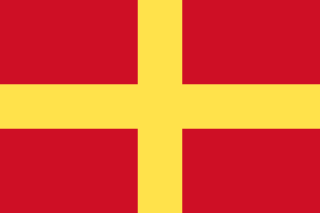
The County of Tripoli (1102–1289) was one of the Crusader states. It was founded in the Levant in the modern-day region of Tripoli, northern Lebanon and parts of western Syria. When the Frankish Crusaders – mostly southern French forces – captured the region in 1109, Bertrand of Toulouse became the first count of Tripoli as a vassal of King Baldwin I of Jerusalem. From that time, the rule of the county was decided not strictly by inheritance but by factors such as military force, favour and negotiation. In 1289 the County of Tripoli fell to Sultan Qalawun of the Muslim Mamluks of Cairo. The county was absorbed into Mamluk Egypt.

Khirbat Jiddin, known in the Kingdom of Jerusalem as Judin, was an Ottoman fortress in the western Upper Galilee, originally built by the Teutonic Order after 1220 as a crusader castle, 16 km northeast of the city of Acre, which at the time was the capital of the Kingdom of Jerusalem. The castle was destroyed by the Mamluk sultan Baibars sometime between 1268-1271 and lay in ruins until being rebuilt and expanded by the Arab ruler Zahir al-Umar as Qal'at Jiddin in the 1760s, only to be destroyed again around 1775 by Jazzar Pasha. The ruined fortress, known as Khirbat Jiddin, was later inhabited by the al-Suwaytat Bedouin tribe.

The Kingdom of Jerusalem, one of the Crusader states that was created in 1099, was divided into a number of smaller seigneuries. According to the 13th-century jurist John of Ibelin, the four highest crown vassals in the kingdom proper were the count of Jaffa and Ascalon, the prince of Galilee, the lord of Sidon, and the lord of Oultrejordain.

Montreal, or Qal'at ash-Shawbak in Arabic, is a castle built by the Crusaders and expanded by the Mamluks, on the eastern side of the Arabah Valley, perched on the side of a rocky, conical mountain, looking out over fruit orchards below. The ruins are located next to the modern town of Shoubak in Jordan.
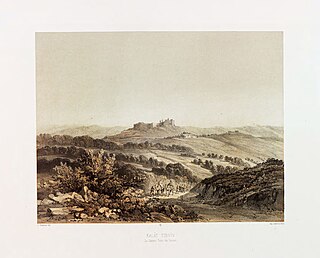
Toron, now Tibnin or Tebnine in southern Lebanon, was a major Crusader castle, built in the Lebanon mountains on the road from Tyre to Damascus. The castle was the centre of the Lordship of Toron, a seigneury within the Kingdom of Jerusalem, actually a rear-vassalage of the Principality of Galilee.

The principality of Galilee was one of the four major seigneuries of the crusader Kingdom of Jerusalem, according to 13th-century commentator John of Ibelin, grandson of Balian. The direct holdings of the principality centred around Tiberias, in Galilee proper, but with all its vassals, the lordship covered all Galilee and southern Phoenicia. The independent Lordship of Sidon was located between Galilee's holdings. The principality also had its own vassals: the Lordships of Beirut, Nazareth, and Haifa.

Kerak Castle is a large medieval castle located in al-Karak, Jordan. It is one of the largest castles in the Levant. Construction began in the 1140s, under Pagan and Fulk, King of Jerusalem. The Crusaders called it Crac des Moabites or "Karak in Moab", as it is referred to in history books. It was also colloquially referred to as Krak of the Desert.
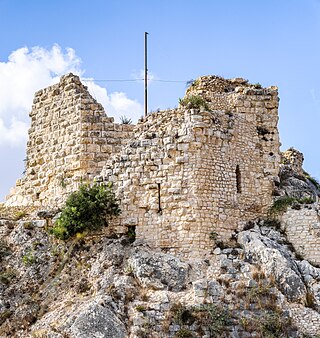
Beaufort or Belfort Castle, known locally as Qal'at al-Shaqif or Shaqif Arnun, is a Crusader fortress in Nabatieh Governorate, Southern Lebanon, about 1 kilometre (0.62 mi) to the south-south-east of the village of Arnoun. There was a fortification on the site before it was captured by Fulk, King of Jerusalem, in 1139 and construction of the Crusader castle probably began soon after. Saladin captured Beaufort in 1190, but 60 years later Crusaders re-took it. In 1268 Sultan Baibars finally captured the castle for the Islamic forces.
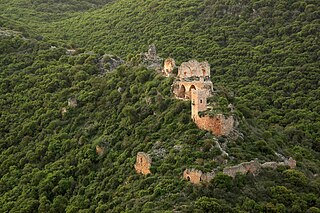
Montfort is a ruined Crusader castle in the Upper Galilee region in northern Israel, about 22 miles (35 km) northeast of the city of Haifa and 10 miles (16 km) south of the border with Lebanon.
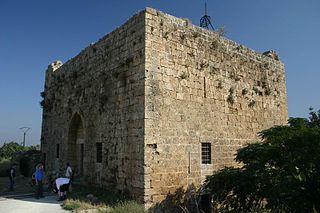
Chastel Rouge, also called Qal’at Yahmur is a small Crusader stronghold in the North West of Syria that belonged to the County of Tripoli. It is also identified as Castrum Rubrum mentioned in Latin texts. The castle stands in the village of Yahmur, at 12 kilometres' distance from Tartus and 10 kilometres from Safita, where the Tortosa and Chastel Blanc Crusader castles can be found.

Le Destroit is a ruined medieval fortified road station, built by the Templars of the Crusader Kingdom of Jerusalem in the early 12th century CE, located on the Mediterranean shore near a site where they later built the Chateau Pelerin castle, today close to the modern town of Atlit, Israel.

The Citadel of Tripoli is a 12th-century fortress in Tripoli, Lebanon. It was built at the top of a hill "during the initial Frankish siege of the city between 1102 and 1109" on the orders of Raymond de Saint-Gilles, who baptized it the Castle of Mount Pilgrim while local Muslims have been referring to it as the Castle of Saint-Gilles. However, very little of the original structure has survived, the castle having been rebuilt several times, and for the last time in the early 19th century, when the citadel was extensively restored and rebuilt by the Ottoman governor of Tripoli Mustafa Agha Barbar. The citadel nowadays houses the North Lebanon & Akkar Museum.

Ein Hemed is a national park and nature reserve in the hills seven kilometres west of modern Jerusalem and some 12 kilometres west of the Old City. It is also known by the Latin name it received from the Crusaders, Aqua Bella, and as Khirbat Iqbalā in Arabic. The park is located on the path of an old Roman road, also used in later periods. The road connected the coastal plain with Jerusalem, passing through Bab al-Wad. A fortified Hospitaller building from the Crusader period, relatively well preserved, is arguably the main attraction beside the streams and lush vegetation.
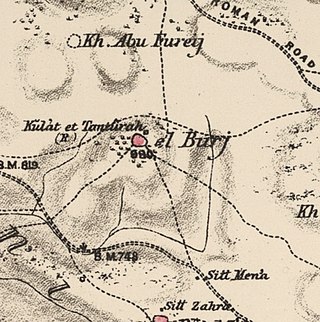
Al-Burj was a Palestinian Arab village 14 km east of Ramle close to the highway to Ramallah, which was depopulated in 1948. Its name, "the tower", is believed to be derived from the crusader castle, Castle Arnold, built on the site. Victorian visitors in the 19th century recorded seeing crusader ruins close to the village.
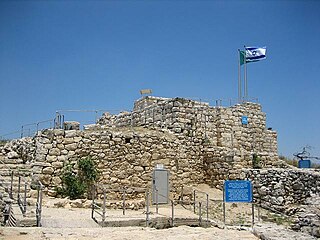
Castel National Park is an Israeli national park, which consists of a fortified summit in the Judean Mountains, at the site of the former Palestinian village of Al-Qastal, known to Hebrew-speakers as HaCástel, "the Cástel". It is located 8 km west of Jerusalem on the road linking it to Tel Aviv.

A cave castle or grotto castle is a residential or refuge castle that has been built into a natural cave. It falls within the category of hill castles. Unlike other types, such castles can only be assaulted from the front, or by drilling through the rock above; the gateway is usually located in the middle of a rock face, which makes it much more difficult to penetrate. Archaeological discoveries have revealed that caves were used as places of refuge as early as the Stone Age. The first medieval cave castles emerged in the 11th and 12th centuries. In the 14th and 15th centuries this type became more widespread, especially in certain parts of France and Switzerland.

The Aqaba Castle or Aqaba Fort, also known as the Mamluk Castle of Aqaba, Jordan, is a Mamluk and Ottoman fortified caravanserai on the pilgrimage route to Mecca and Medina which, in its current form, dates back mainly to the 16th century. In the century preceding the First World War, it was used to a larger degree as a military stronghold.

Tel Tanninim, in Arabic Tell al-Milāt, is an ancient tell on the shore of the Mediterranean, near the mouth of Nahal Tanninim, in the vicinity of the modern Arab town of Jisr az-Zarka, Israel.
The Castle of al-Al, also ʿAlʿāl was, according to contemporary Damascene chronicler Ibn al-Qalanisi, a short-lived castle built in 1105 near al-‘Al on the Golan Heights by Hugh of Saint Omer, the man put in charge of the Galilee by King Baldwin I. The location is described as "between the Sawad and al-Bathaniya". Israeli historian Moshe Sharon considers it to be a mere legend rooted in a popular etymology, with no historical base.

Tancred's Tower, known in Arabic as Qasr (al-)Jalud, was a large tower at the northwest corner of the Old City of Jerusalem, of which only meager remains were unearthed by archaeologists.


